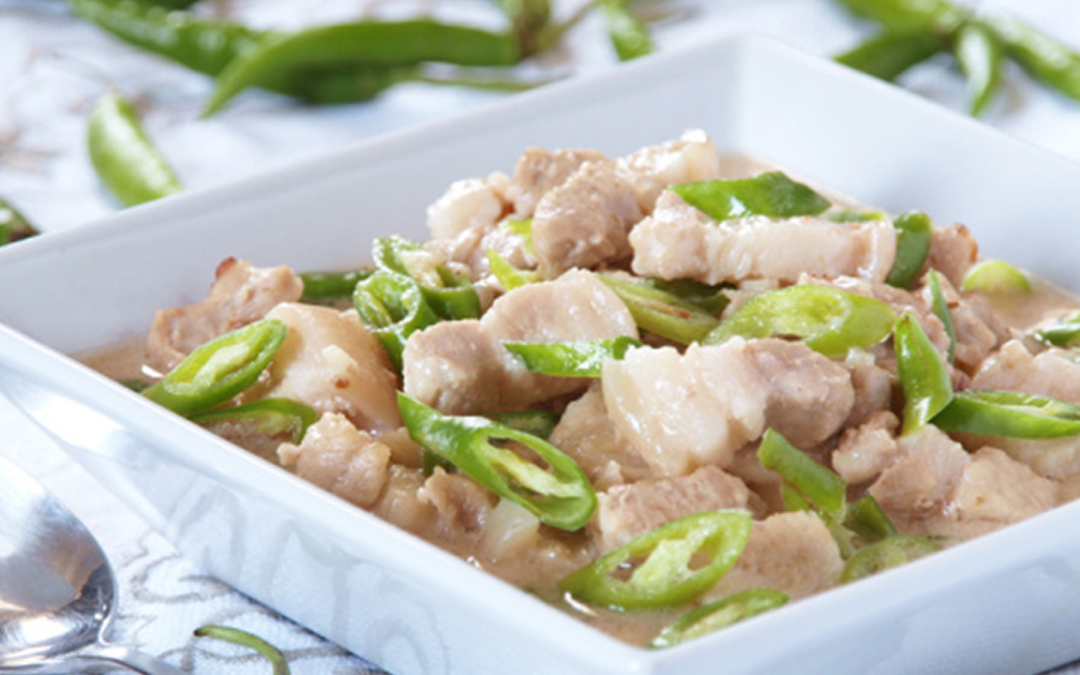
Bicol Express, perhaps the dish most commonly associated with the Bicol Region, may not even be from Bicol.
Bicol Express is a famous stew made with gata (coconut milk) and wild chilies. Traditionally, pork and balaw (shrimp paste) take centerstage, cooking in a luscious, fiery sauce. Innovative cooks, however, have come up with ways to incorporate newer ideas, such as all-seafood or pure vegetarian options. As a matter of fact, in Bicol, more than one café offers Bicol Express ice cream.
The dish takes its name after the train that ferried passengers between Naga City and Manila— that much is certain. But when it comes to retracing its origins, there are many routes to follow. According to some legends, Bicol Express is the acclimatization of an Indonesian dish that Malay traders first introduced in the Bicol Region over two thousand years ago. This origin story may have some merit since coconut milk features heavily in Indonesian cuisine. However, the province’s palm-tree-rich topography also lends itself well to gata-heavy dishes.
Thus, we arrive at the next theory: Bicol Express is supposedly the latest and most enduring species in the evolution of a purely Bicolano dish comprising creamy coconut milk, vegetables, and balaw. Locals described this archaic Bicol Express with the generic description of ginataang sili (vegetables stewed in coconut milk) or, in some parts, gulay na may lada (vegetables with chili). The dish, however, rose to unprecedented levels of fame when Cely Kalaw gave it its memorable moniker.
Depending on who you’re talking to, Kalaw is either the maker or the brander of Bicol Express. Regardless of which side you’re on, however, her name has become forever attached to the dish. Piecing together different narratives, we can glean that she was a Laguna native who visited Naga City and tested various local dishes. She tried to replicate the laing (another coconut milk-based Bicolano dish with taro leaves) in her Manila restaurant and thus came up with a subtly spicy stew of pork and chilies. In coming up with a name for her reinvention, she overheard the daily PNR train rushing to Bicol. The rest has been disputed history.
As is the way with most classic dishes, the best version is the one with which you share a personal connection with. For me, my favorite is my grandmother’s. Like Kalaw, my grandmother did not originally hail from Bicol. She grew up in the neighboring province of Quezon, whose regional cuisine shares a similar flavor profile. My grandfather, on the other hand, lived in Naga after arriving from China. To escape the advancing Japanese, they settled in Bicol where my grandmother spent most of her life. She learned the language, gained friends, found social and business success, and raised her children as well as their children.
Her take of the dish, in my very biased opinion, is distinctly Bicolano. Instead of pork, balaw, a well-used Bicolano ingredient that reflects the region’s seaside, is the highlight. It gives her version an appealing saltiness that works so well with a steaming mound of white rice. She was generous—and it showed in the number of chilies that she added to her recipe. She didn’t tone her Bicol Express down to appeal to a wide group of people. She did it because it’s what she knew it to taste. It’s a little lesson on being yourself.
Bicol Express
Ingredients:
- Cooking oil, as needed
- 4 cloves garlic, peeled and minced
- 1 small ginger, peeled and sliced
- 1 native onion, peeled and chopped
- 100 grams pork belly, cubed
- 1 cup balaw, cleaned and washed
- ½ cup coconut milk
- 3 cups coconut cream
- 15 red bird’s eye chillies, chopped
- Salt and pepper, to taste
Procedure:
- Heat oil in the pan over medium heat and sauté garlic, ginger, and onion until soft and translucent.
- Add pork belly and sauté until cooked.
- Toss in balaw and cook for another 3 minutes.
- Pour in coconut milk and cream along with bird’s eye chilies. Mix. Simmer until the liquid reduces.
- Season with salt and pepper. Serve with hot rice.


Recent Comments